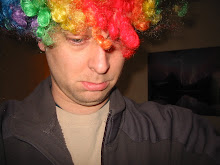 The half-animal/half-plant creature known as the hogweed resembles a large ornamental shrub that’s been trimmed to look something like the farm animal from which it gets its name. What makes the creature even more remarkable is that it uproots itself when physically disturbed or closely approached during the daytime. When this happens, the hogweed will blindly run about in circles for ten minutes or so before settling down again and re-rooting itself, usually bumping into and setting off the others around it in the process.
The half-animal/half-plant creature known as the hogweed resembles a large ornamental shrub that’s been trimmed to look something like the farm animal from which it gets its name. What makes the creature even more remarkable is that it uproots itself when physically disturbed or closely approached during the daytime. When this happens, the hogweed will blindly run about in circles for ten minutes or so before settling down again and re-rooting itself, usually bumping into and setting off the others around it in the process.The hogweed’s leaves and flowers produce a poisonous oil whose effects are activated by natural light and which can last for several years, causing severe burns to the skin of those who come into contact with it, as well as blindness if transferred to the eyes. Those exposed at night often don't know they’ve come into contact with the oil until sunrise, when the light activated oils begin to burn.
In the Dordogne river valley, the creatures grow in densely packed groups of up to a hundred or so, where collectively they appear as normal shrubbery. About once every seven years though, a Giant Hogweed will grow from the seeds of its smaller relatives. These larger specimens can reach heights of up to fifteen feet tall, are far more sensitive to nearby disturbance, and have a rudimentary intelligence and sense of direction.
Hogweeds are not native to the region and have been eradicated from the populated areas of the valley, but still crop up from time to time in more rural places. Foreign travelers hoping to avoid bridge tolls along the Dordogne often encounter hogweeds by seeking out their own crossing points. Petitions to nobles on both sides of the river to stamp them out are not infrequent, yet never seem to result in full extermination. Rumor has it that the ongoing enmity between the north and south is in some way to blame; there’s no doubt that the existence of hogweeds along the border are a useful (if minor) deterrent against enemy incursion.
Hogweed: No. Appearing: d100, HD <1, AC 8[11]; Atk 1 trample (0-1 hp + Special); Move 15; Save 18; CL/XP B/10
Giant Hogweed: No. Appearing: Up to 1 (% chance = number of hogweeds appearing), HD 5; AC 6[13]; Atk 1 trample (2d6 + Special); Move 12; Save 12; CL/XP 5/240
Special: Both giant and normal sized hogweeds attack by attempting to trample their victims and transferring their contact poison. Smaller hogweeds are easily fled from, but giant hogweeds will pursue targets as far as a hundred yards from their smaller hogweed companions. Fire attacks against them are at +4 to hit and +1 damage but if they’re set ablaze, attackers within 20’ (60’ for giant hogweeds) must save vs. poison (gas) or suffer d6 damage per day until cured.
Poison: Contact causes d6 hp of damage per day in a victim if the body part(s) affected is exposed to natural light (roll to see what part of the body was hit - the oil also will penetrate clothing in one day if not washed). Cure disease will remove this affliction. Head or face contact may require a saving roll against blindness.
Sites where hogweeds are disturbed are prone to large population blooms due to their seeds being shed and distributed in the process of their running about. When safely handled they can fetch a good price on the black-market.







5 comments:
I love this idea. Man, the real life hogweed sap is crazy. Scars and blindness...who knew a plant could be so dangerous?
Now you've got me thinking about the Giant Dogwood, noted for its delicate, white or pink flowers and for hunting in packs. Considered more beautiful than its small but vicious cousin.
I see its Latin name is Cornus controversa, BTW, which as far as I can tell should mean the Horn of Argument - a bardic magic item.
I remember seeing these on the news. Gave me a laugh to see someone make a plant creature out of them. You gained a follower, as I'm eager to see what else you can cook up :)
that's just creepy.
@Christian: Thanks! Yeah, they's nasty.
@Richard: It's very Piers Xanthony, isn't it?
@Neko--kun: Welcome aboard and see above. On a related note, you might find Killer Grass to be of interest.
Post a Comment